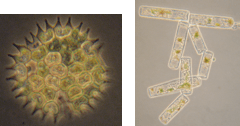The microscopic life around us module is a field laboratory that allows students to experience the abundant invertebrate life in nearby aqueous natural habitats. Students are introduced to the diversity of organisms that exist in something as seemingly simple as a drop of water, using basic keys to identify some of the more common inhabitants. Students can also collect non-aqueous material like hay or twigs, and examine flora and fauna that emerge when the objects are placed in water or various media. A more sophisticated version of the lab involves comparing the abundance and variety of life forms from various water sources, and relating differences to possible environmental factors. For example, samples from ponds treated to eliminate algae or temporary run-off ponds from agricultural sites might be compared to relatively pristine ponds or lakes, or the variation in standing versus rapidly running water examined. Students are encouraged to be creative in examining the world around them. The lab is designed to foster student interest and involvement in scientific inquiry.

Module Protocols
Elementary, Middle/High School
Relevant Concepts
Survey of the diversity of life; Prokaryotic and eukaryotic cells; Interdependence in Nature; Ecosystems and Relationships between Organisms; Species Variation
Next Generation Science Standards Relationships
High School:
HS-LS2-1 Use mathematical and/or computational representations to support explanations of factors that affect carrying capacity of ecosystems at different scales.
HS-LS2-6 Evaluate the claims, evidence, and reasoning that complex interactions in ecosystems maintain relatively consistent numbers and types of organisms in stable conditions, but changing conditions may result in a new ecosystem.
HS-LS4-4 Construct an explanation based on evidence for how natural selection leads to adaptation of populations.
Middle School:
MS-LS1-1 Conduct an investigation to provide evidence that living things are made of cells, either one cell or many different numbers and types of cells.
MS-LS4-4 Construct an explanation based on evidence that describes how genetic variations of traits in a population increase some individuals’ probability of surviving and reproducing in a specific environment.
Elementary School:
1-LS1-1 Use materials to design a solution to a human problem by mimicking how plants and/or animals use their external parts to help them survive, grow, and meet their needs.
3-LS1-1 Develop models to describe that organisms have unique and diverse life cycles but all have in common birth, growth, reproduction, and death.
4-LS1-1 Construct an argument that plants and animals have internal and external structures that function to support survival, growth, behavior, and reproduction.
3-LS3-2 Use evidence to support the explanation that traits can be influenced by the environment.
2-LS4-1 Make observations of plants and animals to compare the diversity of life in different habitats.
3-LS4-2 Use evidence to construct an explanation for how the variations in characteristics among individuals of the same species may provide advantages in surviving, finding mates, and reproducing.
3-LS4-3 Construct an argument with evidence that in a particular habitat some organisms can survive well, some survive less well, and some cannot survive at all.
3-LS4-4 Make a claim about the merit of a solution to a problem caused when the environment changes and the types of plants and animals that live there may change.
See our glossary for the terms used in the modules.